Ford unveiled the Flex for the 2009 model year as a three-row alternative to the minivan, hoping to lure some style-minded buyers away. Sales have consistently been less than a third of what Ford had wanted for the Flex, but enough for the model to stay around for the past seven years. Personally I've always viewed the car as somewhat of an oddity, sporting its own style that's different from the corporate Ford look and retro in nature. But before the major refresh for 2013, the Flex hadn't really come into its own. The front-end of the car was so under-styled that the retro cues put forth by the rest of it were wasted on my eyes. The design was almost there, but the Ford Explorer simply had the edge, selling about five times as many.
Last week, my in-laws came to town and asked me to rent a car I could drive all six of us around in. My options were pretty limited - I think the only other choice was a Dodge Caravan that cost about double what I ended up paying. So, it looked like I was going to be taking another look at the Ford Flex. And thus began my eight days with a 2016, black on black, Ford Flex Limited. Yeah baby.
The 2016 Flex comes in three trim levels starting with the $29,600 SE, the SEL for $32,300, and mine, the Limited, starting at $37,800. The Flex is kind of an anomaly in Ford's lineup, occupying at least on paper, a similar spot to the also seven-seater, platform-sharing Explorer. The Explorer starts around a grand-and-a-half more than the Flex and tops out around seven grand higher at $55k. But there's a reason for these two crossovers to occupy such a similar place in Ford's lineup, and it's not just because Ford classifies the Explorer as an SUV and the Flex as a crossover.
EXTERIOR STYLE
It's fair to say that the Flex has a marmite design, evoking images of an old-fashioned bread van with its long, boxy shape. What's likely awkward looking to some, others, including myself, find the utilitarian nature of its shape attractive in a way. But that's not to say there aren't styling flourishes Ford has thrown in there too. For example, since the 2013 refresh, instead of the standard blue oval front and center on the grill, Ford has instead widely adorned the letters F L E X across the base of the hood. The same goes for the rear of the car where the exterior's only blue oval is located, at the bottom corner of the liftgate. Available only on the SEL and Limited trims, another signature touch is the option to get the roof contrast-painted white, silver, or black depending on the body color. Very cool. This thing is kind of like a big Mini.
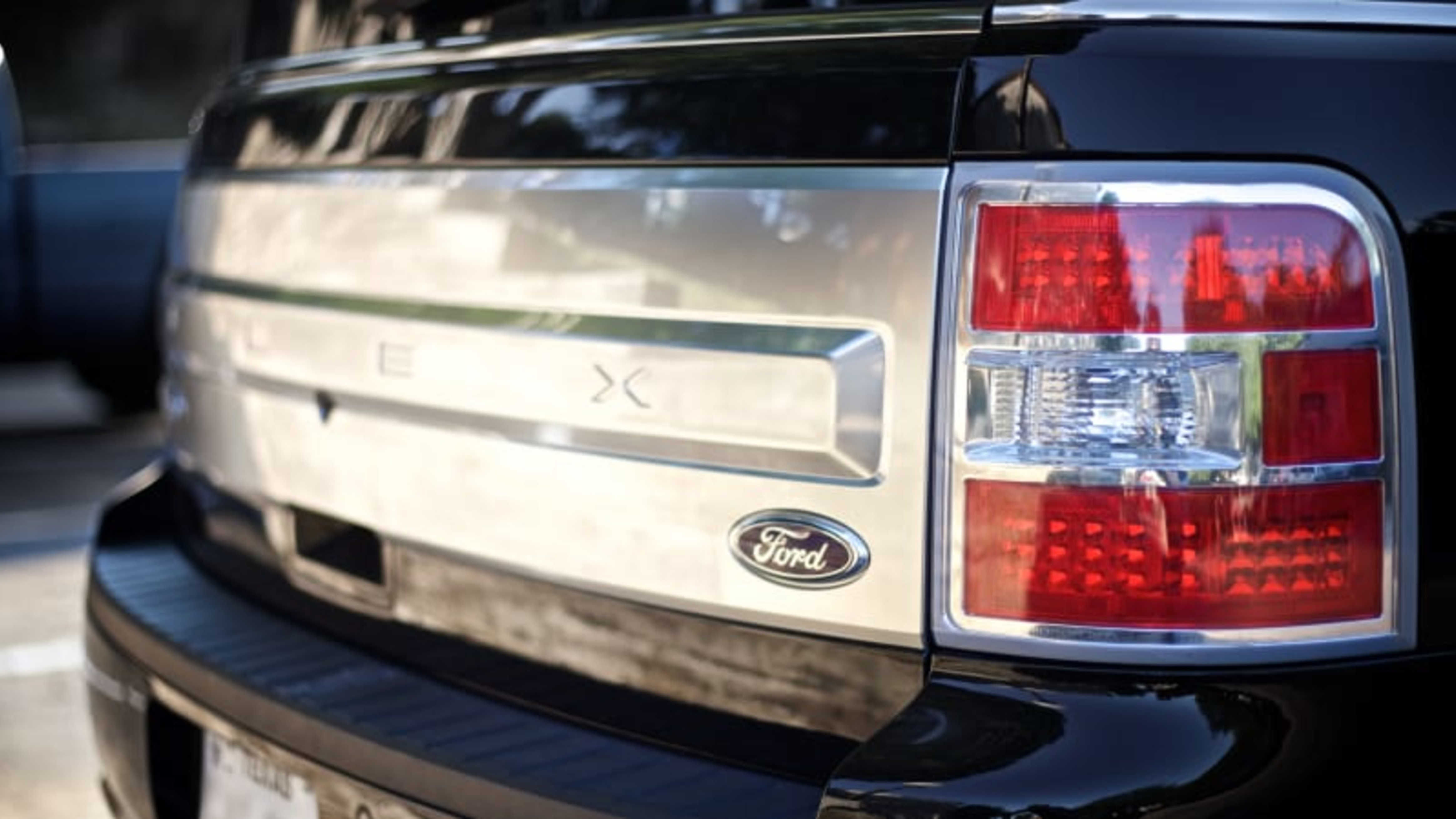
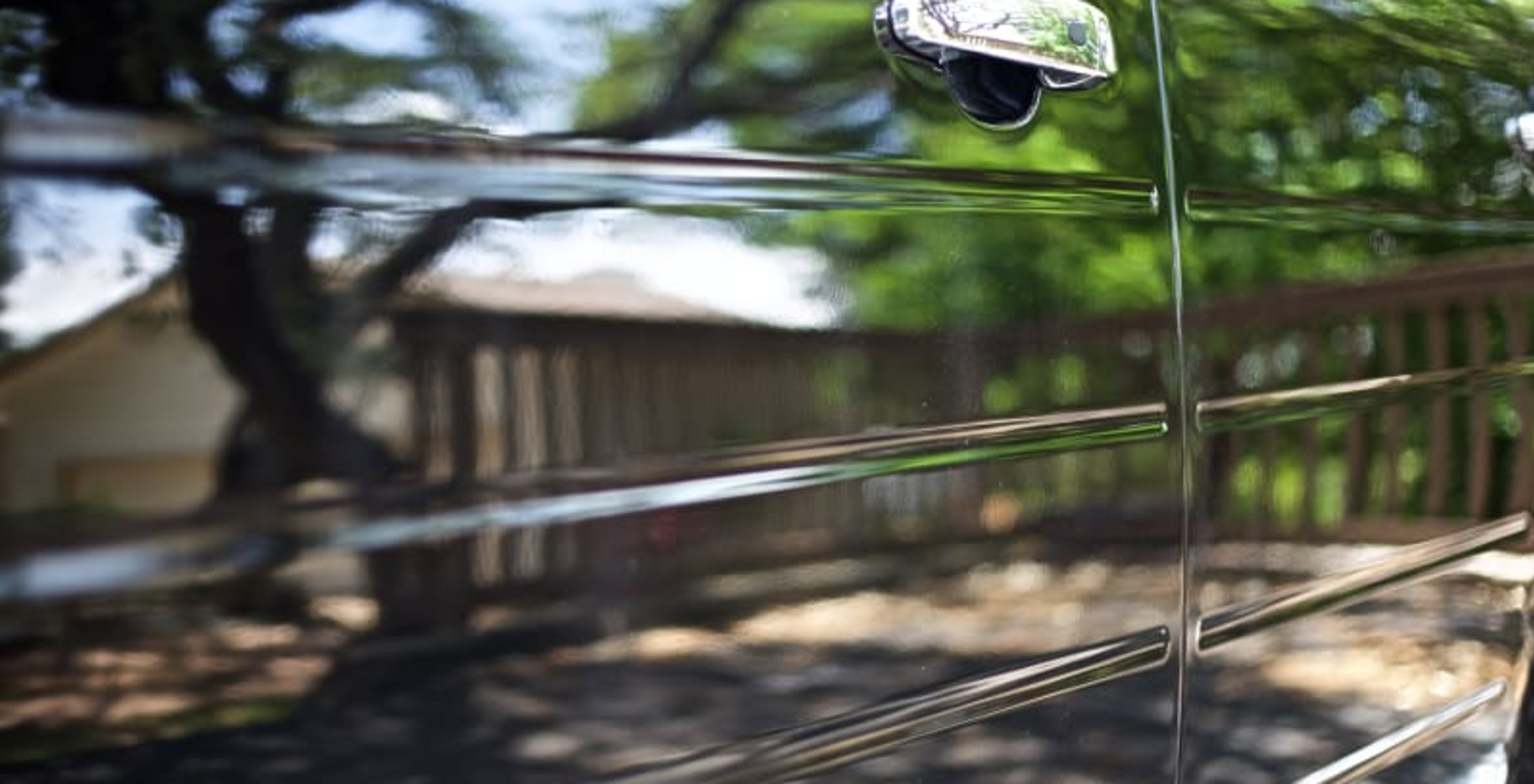
In addition to the contrast-roof and somewhat debadged look, the two other design elements that really "make" the car, are unfortunately only available on the 38 grand Limited model. The first one Ford calls a satin-aluminum appliqué on liftgate. It's that big slab of raw-looking metal covering the entire liftgate under the rear windshield, reminiscent of an old woodie. Further helped by the grooved door panels, not only are these great design features on their own but they smartly fit the language of the rest of the car.
The other element that really completes the car's looks for me are the Limited trim's headlights. SE and SEL Flexes get halogen lamps unbefitting to a car of this price. Sadly, they remind me of the awkward period in Ford's lineup when the Taurus X existed. Yuck. The HIDs on the Limited however, are a sharp looking modern piece that manage to look perfectly at home on a retro design. The only issue I found with these lights are that they didn't have a DRL element, and if you manually switched the auto-headlights on during the day, they didn't shut off when you turned off the car - a feature I definitely prefer.
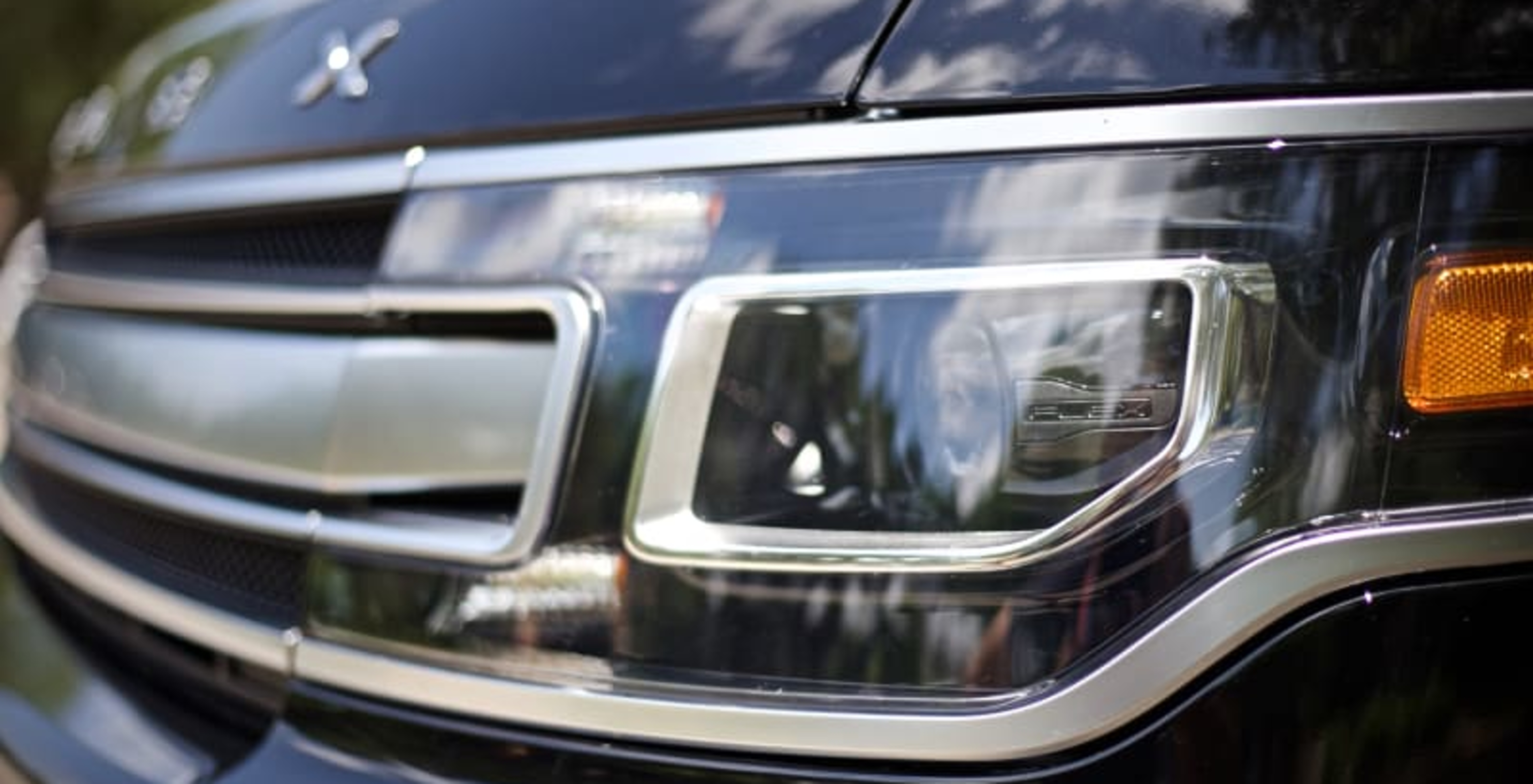
POWERTRAIN
At the end of my street I have to pull out onto a 55mph road, often with a good amount of throttle to safely fade the car into traffic. The Flex struggled here not because it's underpowered. The standard engine on all three trim levels is a naturally-aspirated 3.5 liter Duratec V6 with 287 hp @ 6,500 RPM and 254 lbs-ft at 4,000, and it gets the Flex to 60mph in a bit over 7 seconds. Every time I pulled up to this road, the steering wheel turned and ready to go, with even a judicious amount of throttle, the Flex peeled out, screeching until about a second after I was fully pointed straight and in the lane. Most of this had to do with the FWD, open-differential nature of the drivetrain, but it was an annoying fact of my daily life with the Flex. A smart option, available only on the SEL and Limited trims, is an AWD system which apparently can split torque up to 100% forwards or rearwards based on multiple inputs. At around $2,000, this would severely help the Flex get moving more gracefully, even on dry asphalt.
Like almost every new car, the Flex has an electronic throttle. This means that there's a sensor in the throttle pedal that can be calibrated to respond to foot inputs in any way Ford wants it to compensate for peaks or valleys in the engine's torque curve, to create a smooth experience for the driver. This is not what happens in the Ford Flex. In regular D mode, the Flex, especially when empty of passengers, is jumpy off the line and the throttle is frustratingly difficult to modulate smoothly. And using the 6-speed auto's other forward mode just made things worse.
Labeled "S", this mode, at the risk of insulting every proper sports car ever built, stands for "sport". In "sport"-mode, the throttle pedal requires fractions of a millimeter to modulate, that is, if your goal is to avoid whiplashing your passengers or laying down 235mm wide strips of rubber (yes, the traction control system is that slow to respond). And say you're cruising on the highway in S mode and want to accelerate? When you hit the throttle you have to wait an entire, full, complete, excruciating, one-Mississippi second for it to downshift before you get any forward thrust whatsoever. During a crucial moment in a particular passing maneuver with the Flex, one of these unwanted downshifts put me in the dangerous spot of being without any power in a compromised position. That was a pretty scary one-Mississippi. And all of this busy shifting culminated in me getting only 15 mpg average for my 600 miles with the car - one mpg less than its city rating (16 city/23 hwy/19 combined).
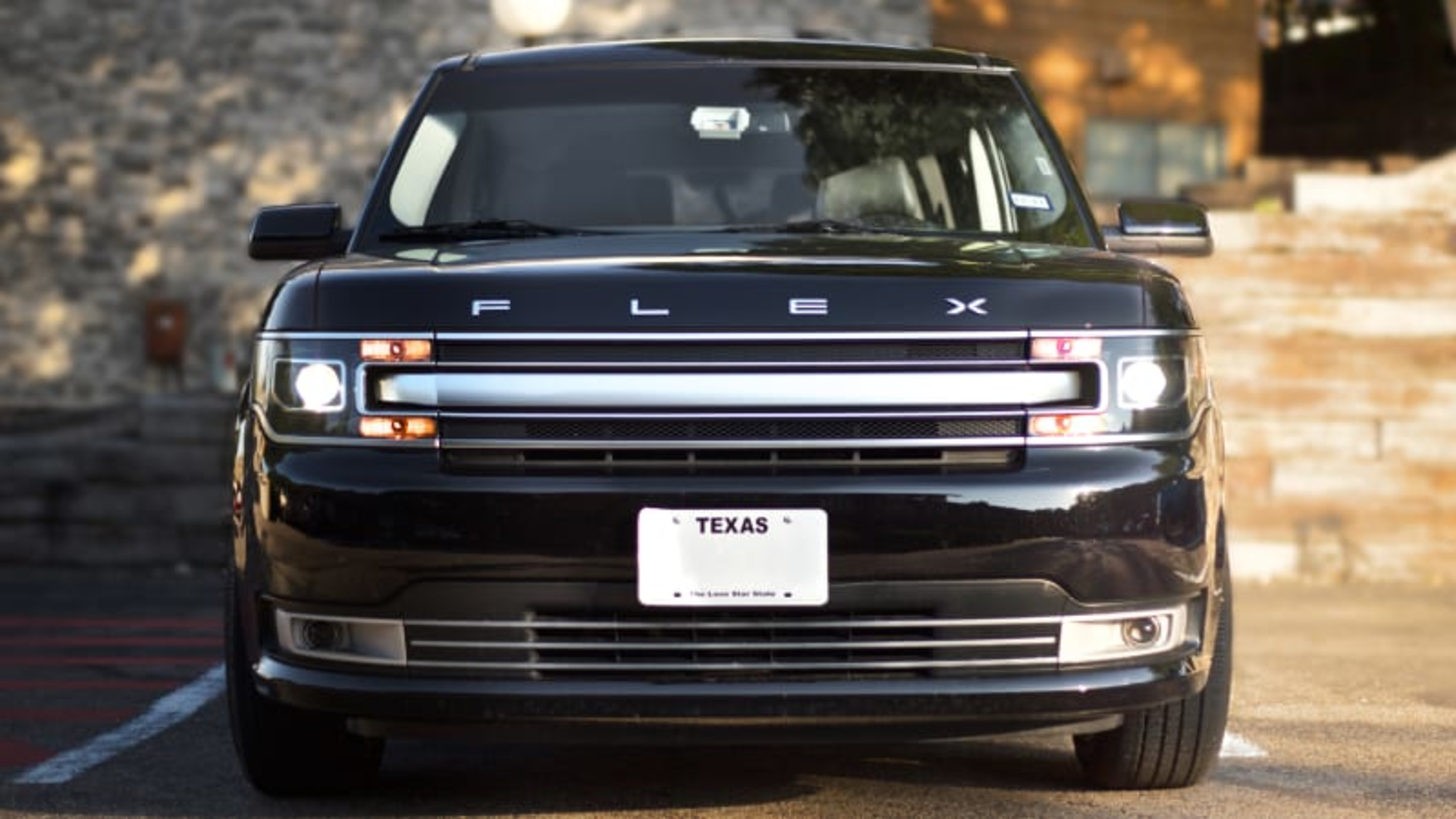
I'm afraid other aspects of the drivetrain didn't elicit much more confidence or pleasure either. Firstly, there's the sound of the V6. It's fairly muted and acceptable down low but as soon as that thing is under pressure in the top half of its rev range, you could swear someone was under the hood angle-grinding into a thick slab of steel. Which is to say that it sounds bad, loudly. One interesting option that's only available on the Limited trim, is an EcoBoost variation of the V6. Officially rated with the exact same fuel economy, this twin-turbo engine makes 365 hp and 350 lbs-ft and smartly, is only available when paired with AWD.
The electric power steering in the Flex is very light, as with so many other cars today, and did not communicate the level of traction the front tires had at all. The thing is, I wouldn't necessarily label that as a negative as I imagine that most owners of a car like this actually prefer their steering to be light and muted. It's not like they'll be doing much performance driving. The steering wheel also consistently transferred all the little bumps from the road along with powertrain vibrations in a way that's probably unfit for a forty-thousand-dollar vehicle. That being said, I thought the steering ratio was perfect and the turning radius was more than acceptable for a vehicle this large.
Operation of the brakes, although effective, bothered me for one particular reason. The pedal is active right at the top, which is good, but as you get deeper into it, there's no added resistance. The brakes on the cars and trucks we drive control so much energy and dissipate so much heat that I think when you're really stomping on it, their operation should require a bit of force. I want the pedal to communicate to me how hard the brakes are working, not just my inner ear. I want the resistance to climb as braking force climbs. This car doesn't have that and I think if nothing else, it doesn't respect the immensity of what the brakes do.
INTERIOR
The interior environment of the Flex Limited is a decent, roomy place to be. I will say, though, that there's something that has been hard for me to put my finger on that's disappointing about it. It's not because the 10-way power black leather driver's seat was a bit too wide for me with not nearly enough bolstering (though I think perhaps that Ford included these seats to accommodate a wider body type than mine). It's not that the visibility was bad - it wasn't - however without the blind spot monitoring system and a backup camera with cross-traffic alert I might feel differently about that. Those features always worked as advertised and without them the Flex would be cumbersome to maneuver around parking lots.
Even the leather was decent. It was fairly soft and better than what BMW's been putting in their 3 Series lately. In fact, the car had about a dozen cupholders, two USB ports, three 12-volt outlets, and even a 110V electrical outlet in the second row. These were all really nice things to have. Another nice thing I can say about the Flex is that the infotainment system, Sync 3, was easy to use. It has a couple of flaws, like how from the home screen, the climate control for the second and third rows is buried under two menus, exacerbated by the fact that the auto climate control inexplicably only controls the front row, leaving the second and third rows completely manual. That, and the font and graphic design of the system is so, so dull.
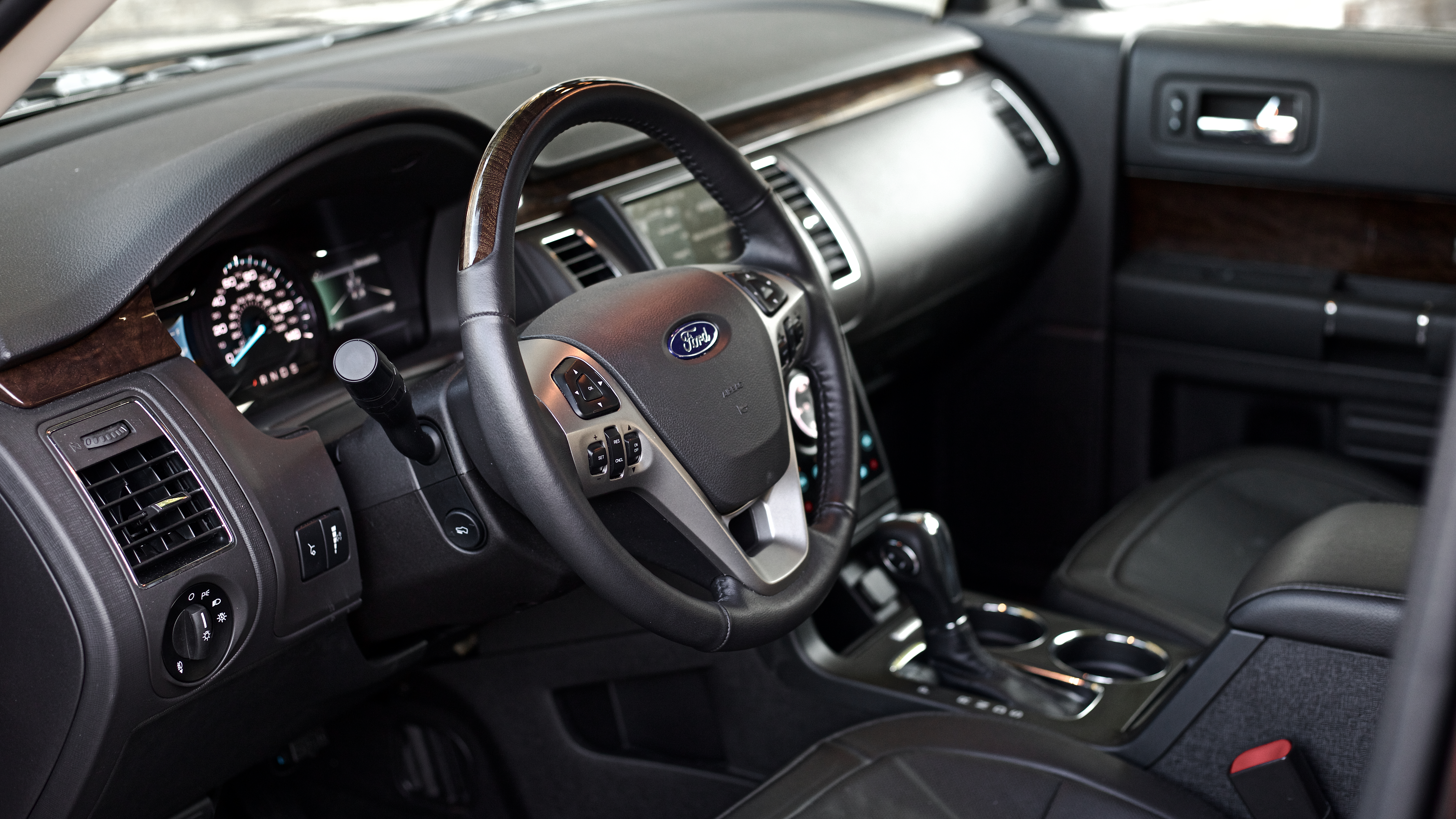
The thing is, the exterior of the post-refresh Flex Limited is, I think, a special looking car. It's daring in the way it goes against the rest of the company's design cues and exists as its own thing. I think perhaps that's why the interior is disappointing. It's not that the Limited model was under-equipped or especially cheap feeling (although it has its moments - think: Igloo-beach-cooler-type plastic on part of the door panel), it's that as soon as you get in the car, you might as well be in any other Ford. None of the charisma of the outside makes its way in.
As far as practicality goes, the power-folding second row seats (passenger side) in my example worked quickly and proved to be very useful, if a bit heavy to unfold manually. Also, both the second and third rows fold down completely flat to create a large cargo area, albeit with a fairly high floor. We drove comfortably with a car seat and an adult in third row, another adult and a rear-facing car seat behind the driver in the second row, and two adults in the front. No, I personally wouldn't want to sit in the third row for a long trip but it's totally possible. In fact, the third row has 1.4 inches more legroom than the new Honda Pilot, and the second row has 5.9 more inches! And, I think it's worth noting that a rear-facing car seat fit comfortably behind me, a long-legged driver who likes to drive with his legs fully extended. It's a testament to how spacious the second row is in the Flex, which even has about five inches more legroom than the Explorer, which is no doubt where the Flex's extra five inches of wheelbase goes to.
VERDICT
I've been asking myself over and over whether this would be the 35- to 40-thousand dollar, three-row crossover I would buy, even though personally, I'm a proponent of driving the smallest car that works for you. I think for most Flex buyers, the styling (of especially the Limited) would be reason number one they headed to their local Ford dealer. I think second row legroom is a noteworthy highlight of the car too. But think about the competition. Is the Ford's quirky exterior styling enough to overcome the average interior and unrefined powertrain? Not for me. I would be taking a closer look at the upcoming all-new Mazda CX-9, the new Honda Pilot, and the Dodge Durango instead.
In a way, the Flex is less of an SUV and more of a modern reinterpretation of those fat-assed, late 80s/early 90s station wagons I remember from when I was young. The Flex is higher off the ground than those, yes, because that's how family cars are generally sold today, but it carries on the utilitarian ethos of a big, boxy shape, with plenty of room inside. So, I guess in conclusion I'm glad Ford took a chance on the Flex by making to begin with, and helping realize it a bit better for its 2013 refresh. Even though it's at least my 4th place in the segment, I'll forever smile when I see one on the street.
Related Video:

Last week, my in-laws came to town and asked me to rent a car I could drive all six of us around in. My options were pretty limited - I think the only other choice was a Dodge Caravan that cost about double what I ended up paying. So, it looked like I was going to be taking another look at the Ford Flex. And thus began my eight days with a 2016, black on black, Ford Flex Limited. Yeah baby.
The 2016 Flex comes in three trim levels starting with the $29,600 SE, the SEL for $32,300, and mine, the Limited, starting at $37,800. The Flex is kind of an anomaly in Ford's lineup, occupying at least on paper, a similar spot to the also seven-seater, platform-sharing Explorer. The Explorer starts around a grand-and-a-half more than the Flex and tops out around seven grand higher at $55k. But there's a reason for these two crossovers to occupy such a similar place in Ford's lineup, and it's not just because Ford classifies the Explorer as an SUV and the Flex as a crossover.
EXTERIOR STYLE
It's fair to say that the Flex has a marmite design, evoking images of an old-fashioned bread van with its long, boxy shape. What's likely awkward looking to some, others, including myself, find the utilitarian nature of its shape attractive in a way. But that's not to say there aren't styling flourishes Ford has thrown in there too. For example, since the 2013 refresh, instead of the standard blue oval front and center on the grill, Ford has instead widely adorned the letters F L E X across the base of the hood. The same goes for the rear of the car where the exterior's only blue oval is located, at the bottom corner of the liftgate. Available only on the SEL and Limited trims, another signature touch is the option to get the roof contrast-painted white, silver, or black depending on the body color. Very cool. This thing is kind of like a big Mini.


In addition to the contrast-roof and somewhat debadged look, the two other design elements that really "make" the car, are unfortunately only available on the 38 grand Limited model. The first one Ford calls a satin-aluminum appliqué on liftgate. It's that big slab of raw-looking metal covering the entire liftgate under the rear windshield, reminiscent of an old woodie. Further helped by the grooved door panels, not only are these great design features on their own but they smartly fit the language of the rest of the car.
The other element that really completes the car's looks for me are the Limited trim's headlights. SE and SEL Flexes get halogen lamps unbefitting to a car of this price. Sadly, they remind me of the awkward period in Ford's lineup when the Taurus X existed. Yuck. The HIDs on the Limited however, are a sharp looking modern piece that manage to look perfectly at home on a retro design. The only issue I found with these lights are that they didn't have a DRL element, and if you manually switched the auto-headlights on during the day, they didn't shut off when you turned off the car - a feature I definitely prefer.

POWERTRAIN
At the end of my street I have to pull out onto a 55mph road, often with a good amount of throttle to safely fade the car into traffic. The Flex struggled here not because it's underpowered. The standard engine on all three trim levels is a naturally-aspirated 3.5 liter Duratec V6 with 287 hp @ 6,500 RPM and 254 lbs-ft at 4,000, and it gets the Flex to 60mph in a bit over 7 seconds. Every time I pulled up to this road, the steering wheel turned and ready to go, with even a judicious amount of throttle, the Flex peeled out, screeching until about a second after I was fully pointed straight and in the lane. Most of this had to do with the FWD, open-differential nature of the drivetrain, but it was an annoying fact of my daily life with the Flex. A smart option, available only on the SEL and Limited trims, is an AWD system which apparently can split torque up to 100% forwards or rearwards based on multiple inputs. At around $2,000, this would severely help the Flex get moving more gracefully, even on dry asphalt.
Like almost every new car, the Flex has an electronic throttle. This means that there's a sensor in the throttle pedal that can be calibrated to respond to foot inputs in any way Ford wants it to compensate for peaks or valleys in the engine's torque curve, to create a smooth experience for the driver. This is not what happens in the Ford Flex. In regular D mode, the Flex, especially when empty of passengers, is jumpy off the line and the throttle is frustratingly difficult to modulate smoothly. And using the 6-speed auto's other forward mode just made things worse.
Labeled "S", this mode, at the risk of insulting every proper sports car ever built, stands for "sport". In "sport"-mode, the throttle pedal requires fractions of a millimeter to modulate, that is, if your goal is to avoid whiplashing your passengers or laying down 235mm wide strips of rubber (yes, the traction control system is that slow to respond). And say you're cruising on the highway in S mode and want to accelerate? When you hit the throttle you have to wait an entire, full, complete, excruciating, one-Mississippi second for it to downshift before you get any forward thrust whatsoever. During a crucial moment in a particular passing maneuver with the Flex, one of these unwanted downshifts put me in the dangerous spot of being without any power in a compromised position. That was a pretty scary one-Mississippi. And all of this busy shifting culminated in me getting only 15 mpg average for my 600 miles with the car - one mpg less than its city rating (16 city/23 hwy/19 combined).

I'm afraid other aspects of the drivetrain didn't elicit much more confidence or pleasure either. Firstly, there's the sound of the V6. It's fairly muted and acceptable down low but as soon as that thing is under pressure in the top half of its rev range, you could swear someone was under the hood angle-grinding into a thick slab of steel. Which is to say that it sounds bad, loudly. One interesting option that's only available on the Limited trim, is an EcoBoost variation of the V6. Officially rated with the exact same fuel economy, this twin-turbo engine makes 365 hp and 350 lbs-ft and smartly, is only available when paired with AWD.
The electric power steering in the Flex is very light, as with so many other cars today, and did not communicate the level of traction the front tires had at all. The thing is, I wouldn't necessarily label that as a negative as I imagine that most owners of a car like this actually prefer their steering to be light and muted. It's not like they'll be doing much performance driving. The steering wheel also consistently transferred all the little bumps from the road along with powertrain vibrations in a way that's probably unfit for a forty-thousand-dollar vehicle. That being said, I thought the steering ratio was perfect and the turning radius was more than acceptable for a vehicle this large.
Operation of the brakes, although effective, bothered me for one particular reason. The pedal is active right at the top, which is good, but as you get deeper into it, there's no added resistance. The brakes on the cars and trucks we drive control so much energy and dissipate so much heat that I think when you're really stomping on it, their operation should require a bit of force. I want the pedal to communicate to me how hard the brakes are working, not just my inner ear. I want the resistance to climb as braking force climbs. This car doesn't have that and I think if nothing else, it doesn't respect the immensity of what the brakes do.
INTERIOR
The interior environment of the Flex Limited is a decent, roomy place to be. I will say, though, that there's something that has been hard for me to put my finger on that's disappointing about it. It's not because the 10-way power black leather driver's seat was a bit too wide for me with not nearly enough bolstering (though I think perhaps that Ford included these seats to accommodate a wider body type than mine). It's not that the visibility was bad - it wasn't - however without the blind spot monitoring system and a backup camera with cross-traffic alert I might feel differently about that. Those features always worked as advertised and without them the Flex would be cumbersome to maneuver around parking lots.
Even the leather was decent. It was fairly soft and better than what BMW's been putting in their 3 Series lately. In fact, the car had about a dozen cupholders, two USB ports, three 12-volt outlets, and even a 110V electrical outlet in the second row. These were all really nice things to have. Another nice thing I can say about the Flex is that the infotainment system, Sync 3, was easy to use. It has a couple of flaws, like how from the home screen, the climate control for the second and third rows is buried under two menus, exacerbated by the fact that the auto climate control inexplicably only controls the front row, leaving the second and third rows completely manual. That, and the font and graphic design of the system is so, so dull.

The thing is, the exterior of the post-refresh Flex Limited is, I think, a special looking car. It's daring in the way it goes against the rest of the company's design cues and exists as its own thing. I think perhaps that's why the interior is disappointing. It's not that the Limited model was under-equipped or especially cheap feeling (although it has its moments - think: Igloo-beach-cooler-type plastic on part of the door panel), it's that as soon as you get in the car, you might as well be in any other Ford. None of the charisma of the outside makes its way in.
As far as practicality goes, the power-folding second row seats (passenger side) in my example worked quickly and proved to be very useful, if a bit heavy to unfold manually. Also, both the second and third rows fold down completely flat to create a large cargo area, albeit with a fairly high floor. We drove comfortably with a car seat and an adult in third row, another adult and a rear-facing car seat behind the driver in the second row, and two adults in the front. No, I personally wouldn't want to sit in the third row for a long trip but it's totally possible. In fact, the third row has 1.4 inches more legroom than the new Honda Pilot, and the second row has 5.9 more inches! And, I think it's worth noting that a rear-facing car seat fit comfortably behind me, a long-legged driver who likes to drive with his legs fully extended. It's a testament to how spacious the second row is in the Flex, which even has about five inches more legroom than the Explorer, which is no doubt where the Flex's extra five inches of wheelbase goes to.
VERDICT
I've been asking myself over and over whether this would be the 35- to 40-thousand dollar, three-row crossover I would buy, even though personally, I'm a proponent of driving the smallest car that works for you. I think for most Flex buyers, the styling (of especially the Limited) would be reason number one they headed to their local Ford dealer. I think second row legroom is a noteworthy highlight of the car too. But think about the competition. Is the Ford's quirky exterior styling enough to overcome the average interior and unrefined powertrain? Not for me. I would be taking a closer look at the upcoming all-new Mazda CX-9, the new Honda Pilot, and the Dodge Durango instead.
In a way, the Flex is less of an SUV and more of a modern reinterpretation of those fat-assed, late 80s/early 90s station wagons I remember from when I was young. The Flex is higher off the ground than those, yes, because that's how family cars are generally sold today, but it carries on the utilitarian ethos of a big, boxy shape, with plenty of room inside. So, I guess in conclusion I'm glad Ford took a chance on the Flex by making to begin with, and helping realize it a bit better for its 2013 refresh. Even though it's at least my 4th place in the segment, I'll forever smile when I see one on the street.
Related Video:



Sign in to post
Please sign in to leave a comment.
Continue